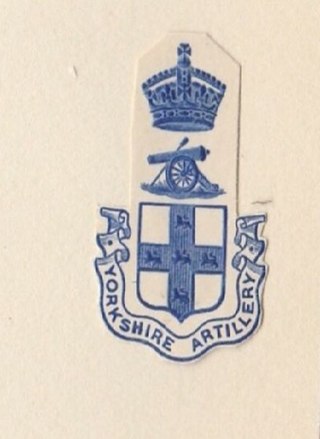The 1st Kent Artillery Volunteers was a part-time unit of the British Army's Royal Artillery from 1860 to 1956. Primarily serving as coastal artillery defending the Port of Dover and other harbours in South-East England, the unit's successors also served in the heavy artillery role on the Western Front during World War I and as anti-aircraft artillery during the Blitz and later in the North African and Italian campaigns of World War II.
The 1st Cinque Ports Artillery Volunteers was a part-time unit of the British Army's Royal Artillery from 1860 to 1956. Raised as coastal defence artillery, the unit later served as field artillery in Mesopotamia during World War I, and as anti-aircraft artillery during the Blitz and in the Middle East during World War II.
The Durham Artillery Militia was a part-time reserve unit of Britain's Royal Artillery based in County Durham from 1853 to 1909. Volunteers from the unit served in the Second Boer War where they distinguished themselves fighting as infantry in the defence of Fort Prospect.

The Yorkshire Artillery Militia was a part-time reserve unit of Britain's Royal Artillery based in the East and North Ridings of Yorkshire from 1860 to 1909.
The Duke of Edinburgh's Own Edinburgh Artillery was a part-time reserve unit of Britain's Royal Artillery based in the City of Edinburgh from 1853 to 1909. Volunteers from the unit served in the Second Boer War.
The Royal Lancashire Militia Artillery was a part-time reserve unit of Britain's Royal Artillery based in Lancashire from 1853 to 1909.
The Antrim Artillery was a part-time reserve unit of Britain's Royal Artillery based in County Antrim, Northern Ireland, from 1853 to 1919. It numbered 1st on the order of precedence of the Militia Artillery. Volunteers from the unit served in the Second Boer War. During World War I it defended Belfast Lough and trained gunners for service overseas. Subsequent units continued the Antrim Artillery traditions.
The Mid-Ulster Artillery Militia was a part-time reserve unit of Britain's Royal Artillery based in Northern Ireland. Formed from three smaller units in 1875, it served until 1909.
The Dublin City Artillery Militia was a part-time reserve unit of Britain's Royal Artillery based in Dublin, Ireland, from 1854 to 1909.
The Galway Militia Artillery was a part-time reserve unit of Britain's Royal Artillery based in County Galway, Ireland, from 1854 to 1888.
The Royal Glamorgan Artillery Militia (RGAM) was a part-time reserve unit of Britain's Royal Artillery based at Swansea in Glamorgan, South Wales, from 1854 to 1909.
The Northumberland Militia Artillery was a part-time reserve unit of Britain's Royal Artillery based in the County of Northumberland, from 1854 to 1909.
The Royal Sussex Militia Artillery was a part-time reserve unit of Britain's Royal Artillery from the County of Sussex, which served from 1853 to 1909.
The Argyll & Bute Militia was a part-time military unit in the west of Scotland from 1798 to 1909, serving in Home Defence during the French Revolutionary War, Napoleonic Wars and Second Boer War. Originally an infantry regiment, it was converted into artillery in 1861.
The Clare Militia was a British militia regiment from 1798 to 1909. It was based in County Clare. At first an infantry unit, it was converted to artillery in 1882, making it the last artillery militia unit raised in the British forces. It was disbanded in 1909.
The 1st Inverness-shire Artillery Volunteers, later the Highland Artillery Volunteers, was a Scottish auxiliary unit of the British Army from 1860 to 1908. With its headquarters in Inverness, it was recruited for home defence from a number of shires in the northern Scottish Highlands. It later provided the basis for a number of Territorial Force units in the Highlands.

The Cinque Ports Division, Royal Artillery was an administrative grouping of garrison units of the Royal Artillery, Artillery Militia and Artillery Volunteers within the British Army's South Eastern District from 1882 to 1889.

The Eastern Division, Royal Artillery, was an administrative grouping of garrison units of the Royal Artillery, Artillery Militia and Artillery Volunteers within the British Army's Eastern District from 1882 to 1902.
The Fifeshire Militia was an auxiliary regiment raised in Fifeshire, Scotland, in 1798. It served in home defence during the Napoleonic Wars and again during the Crimean War when it was converted into an artillery unit as the Fifeshire Artillery Militia. It served in home defence again during the Indian Mutiny and the Second Boer War. It was disbanded in 1909.

